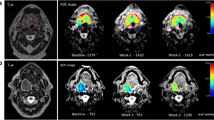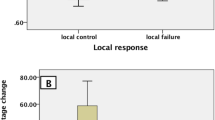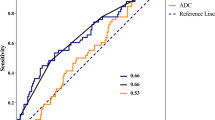Abstract
Objective
To evaluate diffusion-weighted (DWI) magnetic resonance imaging (MRI) for treatment prediction during chemoradiotherapy (CRT) of head and neck squamous cell carcinoma (HNC).
Methods
Thirty patients with HNC underwent echo-planar DWI and anatomical MRI before and 2 and 4 weeks into CRT. Patient follow-up lasted 2 years post-CRT. Tumour ADC (ΔADC) and volume changes (ΔV) between baseline, and 2 and 4 weeks’ follow-up were compared for lesions with recurrence versus complete remission (CR) using a Mann-Whitney U test. The predictive value of the ΔADC and ΔV for locoregional control (LRC) was examined with the Kaplan-Meier method. The study was approved by the local ethics committee. All patients gave written informed consent.
Results
The ΔADC in primary tumours and nodal metastases, 2 and 4 weeks after the start of CRT, was significantly lower in lesions with post-CRT recurrence than in lesions with CR (ΔADC2 weeks and ΔADC4 weeks for primary tumours, relative to nodal metastases: p < 0.0001). The ΔV only showed a significant difference for primary tumours at 2 weeks (ΔV2 weeks: p = 0.03). The ΔADC correlated significantly with 2-year LRC (p < 0.001); the ΔV did not (p > 0.05).
Conclusion
DWI during CRT for HNC allows more accurate response prediction than anatomical imaging, correlating significantly with 2-year LRC.






Similar content being viewed by others
References
Ang KK, Harris J, Garden AS et al (2005) Concomitant boost radiation plus concurrent cisplatinum for advanced head and neck carcinomas: Radiation Therapy Oncology Group phase II trial 99-14. J Clin Oncol 23:3008–3015
Nuyts S, Dirix P, Clement P et al (2009) Impact of adding concomitant chemotherapy to hyperfractionated accelerated radiotherapy for advanced head-and-neck squamous cell carcinoma. Int J Radiat Oncol Biol Phys 15:1088–1095
Pignon JP, Bourhis, Domenge C et al (2000) Chemotherapy added to locoregional treatment for head and neck squamous-cell carcinoma: three meta-analyses of updated individual data. MACH-NC collaborative group. Meta analysis of chemotherapy on head and neck cancer. Lancet 18:949–955
Gregoire V, De Neve W, Eisbruch A et al (2007) Intensity-modulated radiation therapy for head and neck carcinoma. Oncologist 12:555–564
Klug C, Keszthelyi D, Ploder O et al (2004) Neoadjuvant chemoradiotherapy of oral cavity and oropharyngeal: evaluation of tumor response by CT differs from histopathologic response assessment in a significant fraction of patients. Head Neck 26:224–231
Denys D, Kumar P, Wong FS et al (1997) The predictive value of tumor regression rates during chemoradiation therapy in patients with advanced head and neck squamous cell carcinoma. Am J Surg 174:561–564
Jaulerry C, Dubray B, Brunin F et al (1995) Prognostic value of tumor regression during radiotherapy for head and neck cancer: a prospective study. Int J Radiat Oncol Biol Phys 33:271–279
Kostakoglu L, Goldsmith SJ (2004) PET in the assessment of therapy response in patients with carcinoma of the head and neck and of the esophagus. J Nucl Med 45:56–68
Geets X, Tomsej M, Lee JA et al (2007) Adaptive biological image-guided IMRT with anatomic and functional imaging in pharyngo-laryngeal tumors: impact on target volume delineation and dose distribution using helical tomotherapy. Radiother Oncol 85:105–115
Madani I, Duthoy W, Derie C et al (2007) Positron emission tomography-guided, focal-dose escalation using intensity-modulated radiotherapy for head and neck cancer. Int J Radiat Oncol Biol Phys 68:126–135
Le Bihan D, Breton E, Lallemand D et al (1988) Separation of diffusion and perfusion in intravoxel incoherent motion MR imaging. Radiology 168:497–505
Bammer R (2003) Basic principles of diffusion-weighted MRI. Eur J Radiol 45:169–184
Ross BD, Moffat A, Lawrence TS et al (2003) Evaluation of cancer therapy using diffusion magnetic resonance imaging. Mol Cancer Ther 2:581–587
Thoeny HC, De Keyzer F (2007) Extracranial applications of diffusion-weighted magnetic resonance imaging. Eur Radiol 17:1385–1393
Koh DM, Collins DJ (2007) Diffusion-weighted MRI in the body: applications and challenges in oncology. Am J Roentgenol 188:1622–1635
Vandecaveye V, De Keyzer F, Nuyts S et al (2007) Detection of head and neck squamous cell carcinoma with diffusion weighted MRI after (chemo)radiotherapy: correlation between radiologic and histopathologic findings. Int J Radiat Oncol Biol Phys 67:960–971
Hamstra DA, Lee KC, Moffat BA et al (2008) Diffusion magnetic resonance imaging: an imaging treatment response biomarker to chemoradiotherapy in a mouse model of squamous cell cancer of the head and neck. Transl Oncol 1:187–194
Vandecaveye V, De Keyzer F, Hermans R (2008) Diffusion-weighted magnetic resonance imaging in neck lymph adenopathy. Cancer Imaging 30:173–180
Robbins KT, Medina JE, Wolfe GT et al (1991) Standardizing neck dissection terminology. Official report of the Academy’s Committee for Head and Neck Surgery and Oncology. Arch Otolaryngol Head Neck Surg 117:601–605
Padhani AR, Ollivier L (2001) The RECIST (response evaluation criteria in solid tumors): implications for diagnostic radiologists. Br J Radiol 74:983–986
Citrin D, Mansueti J, Likhacheva A et al (2009) Long-term outcomes and toxicity of concurrent paclitaxel and radiotherapy for locally advanced head-and-neck cancer. Int J Radiat Oncol Biol Phys 74:1040–1046
Rapidis AD, Vermorken JB, Bourhis J (2008) Targeted therapies in head and neck cancer: past, present and future. Rev Recent Clin Trials 3:156–166
Yankeelov TE, Lepage M, Chakravarthy A et al (2007) Integration of quantitative DCE-MRI and ADC mapping to monitor treatment response in human breast cancer: initial results. Magn Reson Imaging 25:1–13
Moffat BA, Chenevert TL, Meyer CR et al (2006) The functional diffusion map: an imaging biomarker for the early prediction of cancer treatment outcome. Neoplasia 8:259–267
Patterson DM, Padhani AR, Collins DJ (2008) Technology insight: water diffusion MRI—a potential new biomarker of response to cancer therapy. Nat Clin Pract Oncol 5:220–233
Kim H, Morgan DE, Zeng H et al (2008) Breast tumor xenografts: diffusion-weighted MR imaging to assess early therapy with novel apoptosis-inducing anti-DR5 antibody. Radiology 248:844–851
Seierstad T, Røe K, Olsen DR (2007) Noninvasive monitoring of radiation-induced treatment response using proton magnetic resonance spectroscopy and diffusion-weighted magnetic resonance imaging in a colorectal tumor model. Radiother Oncol 85:187–194
Moffat BA, Chenevert TL, Lawrence TS et al (2005) Functional diffusion map: a noninvasive MRI biomarker for early stratification of clinical brain tumor response. Proc Natl Acad Sci USA 102:5524–5529
Kim S, Loevner L, Quon H et al (2009) Diffusion-weighted magnetic resonance imaging for predicting and detecting early response to chemoradiation therapy of squamous cell carcinomas of the head and neck. Clin Cancer Res 15:986–994
Harry VN, Semple SI, Gilbert FJ et al (2008) Diffusion-weighted magnetic resonance imaging in the early detection of response to chemoradiation in cervical cancer. Gynecol Oncol 111:213–220
Mardor Y, Pfeffer R, Spiegelmann R et al (2003) Early detection of response to radiation therapy in patients with brain malignancies using conventional and high b-value diffusion-weighted magnetic resonance imaging. J Clin Oncol 21:1094–1100
Hamstra DA, Galbán CJ, Meyer CR et al (2008) Functional diffusion map as an early imaging biomarker for high-grade glioma: correlation with conventional radiologic response and overall survival. J Clin Oncol 26:3387–3394
Padhani AR, Liu G, Koh DM et al (2009) Diffusion-weighted magnetic resonance imaging as a cancer biomarker: consensus and recommendations. Neoplasia 11:102–125
Thoeny HC, De Keyzer F, Vandecaveye V et al (2005) Effect of vascular targeting agent in rat tumor model: dynamic contrast-enhanced versus diffusion-weighted MR imaging. Radiology 237:492–499
Abdel Razek AA, Kandeel AY, Soliman N et al (2007) Role of diffusion-weighted echo-planar MR imaging in differentiation of residual or recurrent head and neck tumors and posttreatment changes. AJNR Am J Neuroradiol 28:1146–1152
Vandecaveye V, De Keyzer F, Hermans R (2008) Diffusion-weighted imaging in neck lymph adenopathy. Cancer Imaging 30:173–180
King AD, Ahuja AT, Yeung DK et al (2007) Malignant cervical lymphadenopathy: diagnostic accuracy of diffusion-weighted MR imaging. Radiology 245:806–813
Tozer DJ, Davies GR, Altmann DR et al (2006) Principal component and linear discriminant analysis of T1 histograms of white and gray matter in multiple sclerosis. Magn Reson Imaging 24:793–800
Brun E, Kjellén E, Tennvall J et al (2002) FDG PET studies during treatment: prediction of therapy outcome in head and neck squamous cell carcinoma. Head Neck 24(2):127–135
Dirix P, Vandecaveye V, De Keyzer F, et al (2009) Diffusion-weighted MRI for nodal staging of head and neck squamous cell carcinoma: impact on radiotherapy planning. Int J Radiat Oncol Biol Phys 251:134-146
Author information
Authors and Affiliations
Corresponding author
Additional information
This work was partly financially supported by the research grant “Prof. em. A.L. Baert, Siemens Medical Solutions”.
Rights and permissions
About this article
Cite this article
Vandecaveye, V., Dirix, P., De Keyzer, F. et al. Predictive value of diffusion-weighted magnetic resonance imaging during chemoradiotherapy for head and neck squamous cell carcinoma. Eur Radiol 20, 1703–1714 (2010). https://doi.org/10.1007/s00330-010-1734-6
Received:
Revised:
Accepted:
Published:
Issue Date:
DOI: https://doi.org/10.1007/s00330-010-1734-6




